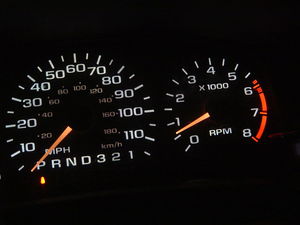.
Redline
Redline refers to the maximum engine speed at which an internal combustion engine and its components are designed to operate without causing damage to the components themselves or other parts of the engine. The redline of an engine depends on various factors such as stroke, mass of the components, displacement, composition of components, and balance of components.
Engines with short strokes can handle higher RPM because there is less force in reciprocating motion. Lighter components can increase the redline as well, since they have less inertia and decrease forces present in the engine.
An engine's redline is described by the manufacturer, who usually determines it by stress-testing the engine.
Redlines vary anywhere from a few hundred revolutions per minute (RPM) (in very large engines such as those in trains and generators) to more than ten thousand of RPM (in smaller, usually high-performance engines such as motorcycles and sports cars). Diesel engines normally have lower redlines than comparatively-sized gasoline engines. Gasoline automobile engines typically will have a redline at around 5600 to 6500 RPM. The VTEC engine in the '00-'03 Honda S2000 had the highest production car redline at 9000 RPM. The Renesis engine in the current Mazda RX-8 also has a redline of 9000 RPM. Because their pistons have less mass, motorcycle engines may have higher redlines.
The actual term redline comes from the red bars that are displayed on tachometers in cars starting at the RPM that denotes the redline for the specific engine. Operating an engine in this area is known as redlining. Straying into this area usually does not mean instant engine failure, but may increase the chances of damaging the engine.
Most modern cars have computer systems that prevent the engine from straying too far into the redline by cutting fuel flow to the fuel injectors/carburetor or by disabling the ignition system until the engine drops to a safer operating speed. Electronic Control Units (ECUs) of automatic transmission cars will upshift before the engine hits the redline even with maximum acceleration (an automatic transmission sport car's ECU will allow the engine to go nearer the redline or hit the redline before upshifting). If manual override is used, the engine will go past redline for a brief amount of time before the ECU will auto-upshift. When the car is in top gear and the engine is in redline (due to high speed), the ECU will cut fuel to the engine, forcing it to slow down until the car slows down and will then release fuel back to the engine, allowing it to speed up again.

